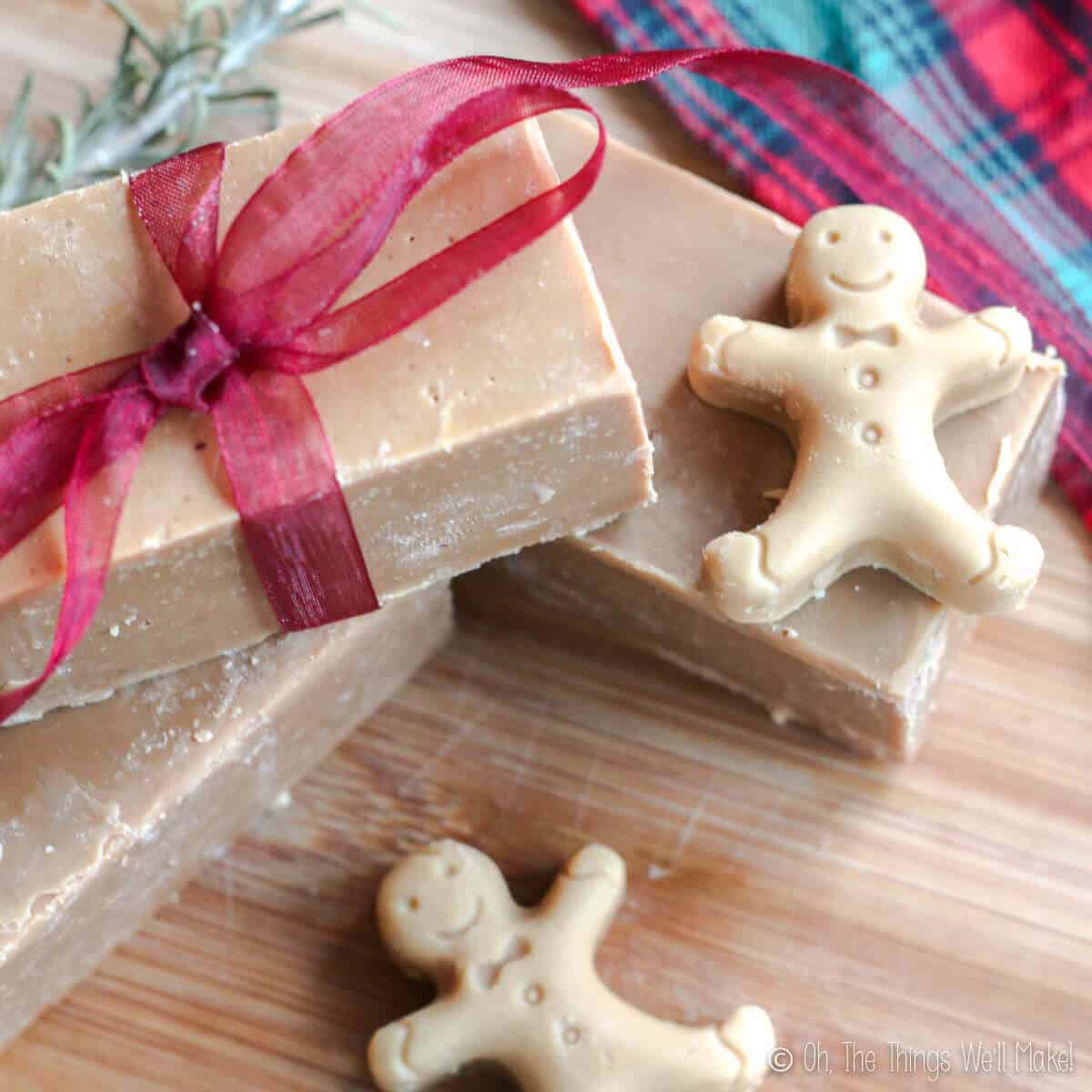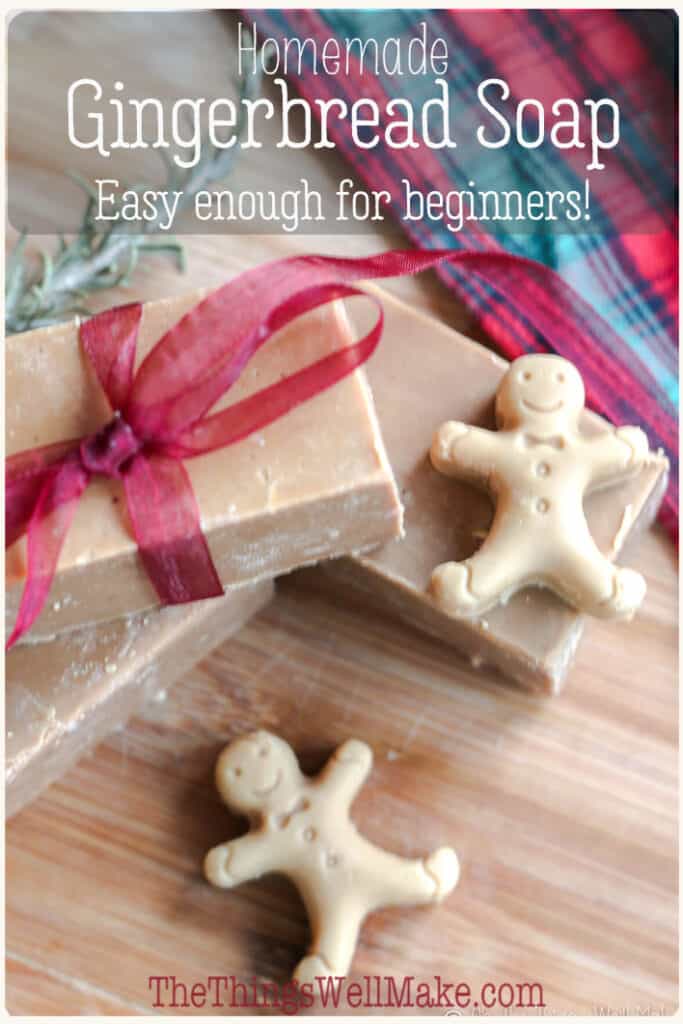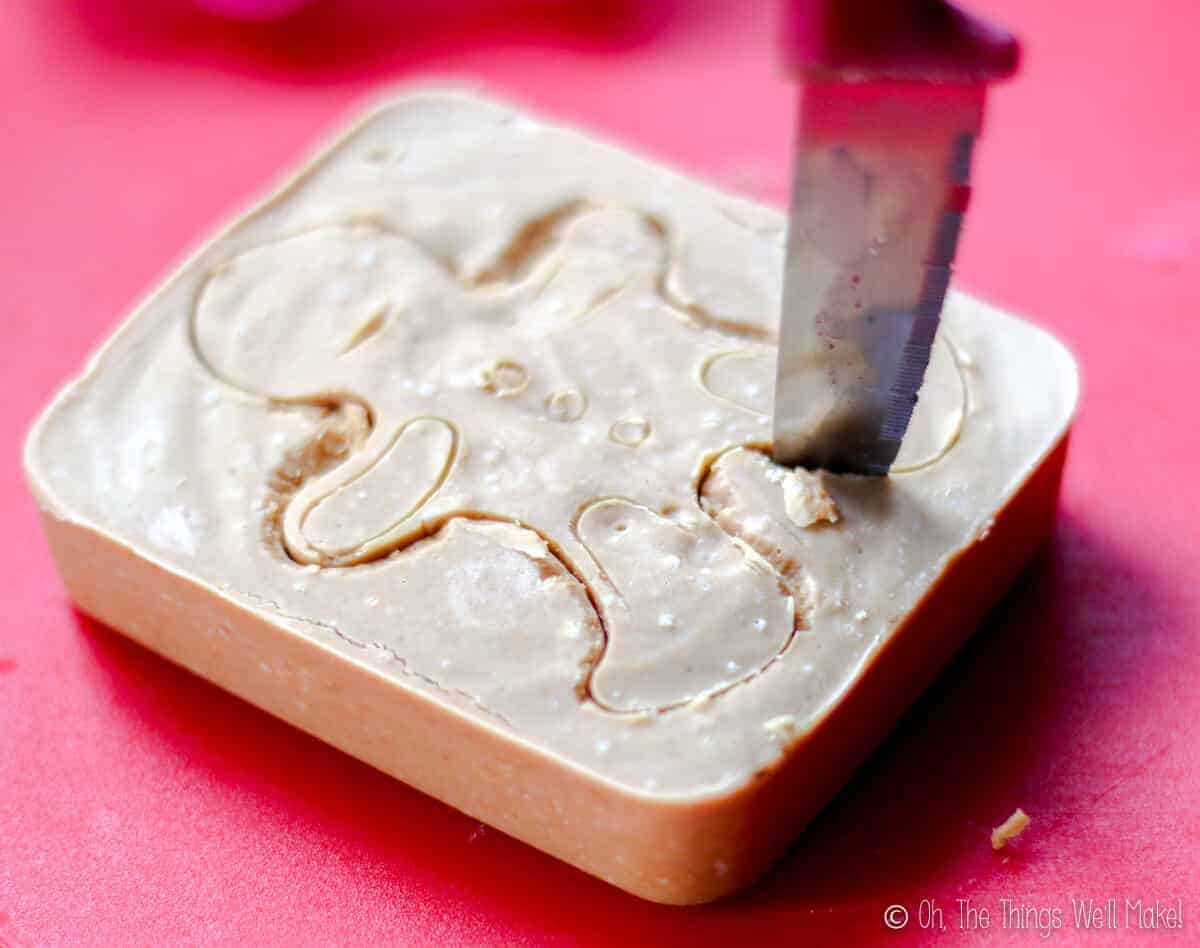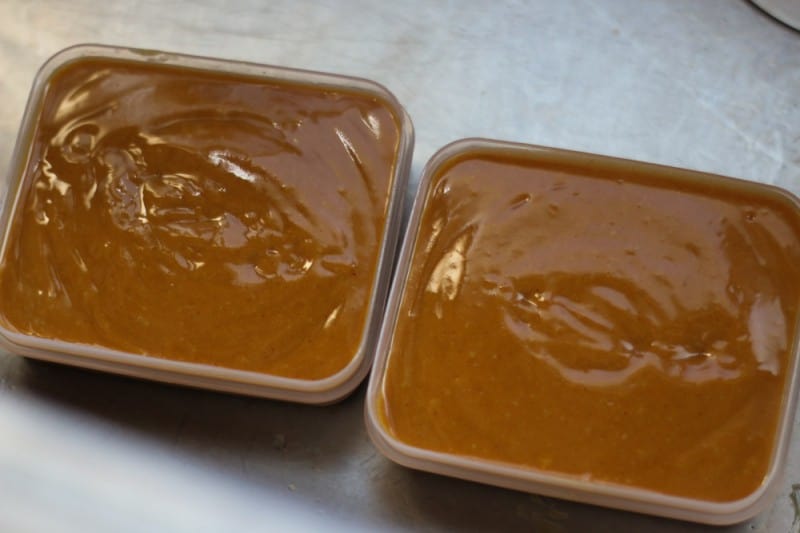The perfect stocking stuffer, this homemade gingerbread soap is easy enough for beginners to make. It has a lovely fragrance that reminds you of the holidays.

Lately, I have been having a lot of fun making new holiday soap recipes.
Christmas is the perfect time for making soap because it makes such a practical, impressive DIY gift.
Adapting the beginner soap recipe
This year, I decided to stick with something simple. I decided to adapt my easy beginner soap recipe so that you can see some of the many ways that you can adapt a recipe to suit your needs without changing out oils or needing to use a lye calculator.
You can find the basic recipe with tips for beginner soapmakers here…
Easy Basic Beginner Soap

Why and How to add Molasses
Molasses is a great addition to soap. It helps give gingerbread its characteristic taste and color, so I knew it would be important to add it to the soap. Not only did the molasses naturally give the soap a beautiful gingerbread color, but it also contributes minerals that help nourish the skin. Plus, the sugar in it helps make more lather.
At first, my easy soap wasn’t as easy as I thought. I made this when I still didn’t know a lot about the best way to add in sugars like molasses and decided to add it directly into the lye solution. The lye reacted strongly with the sugar making for a slightly explosive reaction.
The next time I chose to add the molasses during trace and it worked out much better.

Using chai tea for the lye solution
Rather than use plain distilled water, I decided to make the lye solution with chai tea instead. It’s not something that you need to do if you don’t want to. I’m not really sure how much of a difference it makes, but I wanted to show you that using teas or infusions is yet another way to customize a soap recipe.
For the gingerbread soap, I figured that using a chai tea would add a bit more color to the soap and would also add more of a spiced scent.
If using a tea, let it cool before adding the lye to it to avoid any sort of explosive reaction with the lye. (For more information about lye, check out my post about lye in soap making.)
For those looking how to make chai tea from scratch, I have a recipe up on the blog.
Bulk Chai Tea Recipe


Choosing your molds
I love using silicone molds more soap making. The soaps don’t stick to the silicone, and the flexibility of the molds makes it easier for the removal of the soaps when set. That said, plastic Tupperware-type containers also work well for the same reasons.
For this project, I made a variety of soaps. I used a silicone loaf pan for making the bars of soap.
I also filled some smaller plastic containers to around 2 cm depth to cut out some gingerbread man soaps with cookie cutters. While I think it makes a cute gift that way, I must admit that I like the practicality of a bar of soap much better. (Note that my cutter was too shallow for cutting the soap so I had to finish the cut with a knife.)
I also used some holiday silicone candy molds to make some cute, tiny soaps shaped like gingerbread men.
Gingerbread Soap Recipe

Easy Gingerbread Soap
Materials
Instructions
- Make the lye solution by pouring the lye into the chai tea or water (your choice) and stirring until the lye has completely dissolved. The solution will get very hot and will slowly cool down. As always, add your lye to your water and not the other way around!
- Let the solution slightly cool in an area where it won't be touched or knocked over by other people or pets. Meanwhile, mix together the olive oil and coconut oil.If making this soap in cold temperatures, when coconut oil is in its solid state, I recommend melting it before continuing. Some people prefer to heat their oils, but I don't find it necessary. The remaining heat from the lye solution will slightly warm up the oils. You can also now take the time to prepare your molds as needed. If using a wooden mold, line your mold with parchment paper or a silicone liner.
- When the lye solution has cleared up and isn't too hot to work with anymore, pour the lye mixture into the oil mixture and carefully stir them together. Once you have incorporated the lye solution into the oils you can begin to mix them together with a hand blender.
- When you start to reach trace, the point in the soap making process in which your mixture gets opaque and begins to look like a thin mayonnaise, add in the molasses and essential oils.
- For the essential oils, I used mostly ginger essential oil, some cinnamon, and a few drops of clove oil. I have to admit that I don't normally measure out the essential oils that I use in soaps because I prefer to use small amounts. I let my nose guide me. (I'd estimate I use around 5ml of EOs overall).
- Fully incorporate all of the ingredients, and pour them into your prepared molds.
- Set the soap aside for at least 24 hours. After 24 hours have passed, or when you can unmold the soap without it deforming, carefully unmold your soap. If you used a large mold, you can cut your soap into bars at this stage (or cut the soap with gingerbread man cookie cutters).
- Leave your soap to fully harden and cure for about a month. To help the process, leave space between each bar, and turn them over every couple of days during the first week or so.
- Enjoy your soap!
Notes
Holiday Gift Giving Tips
If you want to present this soap as a gift, consider making these easy snowflake gift pouches. They’re a simple, beautiful craft, and soaps fit in them perfectly.
Painted snowflake pouches

Looking for another holiday-themed soap you can make? Why not try your hand at making these cute peppermint soaps…
Peppermint Soap

This post was originally published on December 6, 2014. It was rewritten in December of 2019, adding clearer instructions and new ideas for gift giving.
 Español
Español












 How to Paint a Snowflake Christmas Gift Pouch
How to Paint a Snowflake Christmas Gift Pouch
Joanne
Hi Tracy. Thank you for your reply 🙂
Yes that’s what I did. Used 80g sodium hydroxide (powder/ grains) mixed with the chai from bottled water. It did take a long time to come to the trace consistency you mentioned then after I added the oils and molasses it started to get really tacky so I got it in to the mounds as quickly as possible but the ginger bread men still came out clumpy, big gaps and 24 hours later I could work them back in to a ball. They’re speckled brown, almost like they’ve been baked with wholemeal flour or something. When I was mixing the solution with the blender (I tried by hand but it just wasn’t coming), I got some of the soap splashed on me and it felt really harsh, like dish soap and was really drying on my sensitive skin. It’s ok now I’ve used the finished product but I’d say still quite drying. I made a second batch using 80g of lye solution (powder and tea) but that never thickened up (obviously I guess as it wasn’t the right ratio). I found my lye got down to 50° in about 15 minutes as the first batch that I left to dissolve for an hour was down to 20°.
I used the 50° each for oils and lye as mentioned in another page on how to make lye and soap as there weren’t any temperature or lye making instructions on here.
I also tried with the last batch of fail soap to heat it up to remould, just went lumpy like when you’ve added water to burned chocolate!
Any tips would be greatly appreciated as I was thinking of giving up as it’s already set me back £12 but I have enough stuff left if I buy another bottle of olive oil so may give it one more go!
Tracy Ariza
Hi Joanne,
Sorry to take so long to get back to you. I have had a super busy week, and haven’t gotten to the computer until today, and wanted to give you a detailed answer!
I’ve been giving this some thought and can’t really figure out what could have happened.
I have updated the instructions of the recipe a little to help clarify things a little better for other people. I guess at the time I was assuming that people were making this as a fun alternative for the easy, beginner soap recipe, and since the instructions are a bit more detailed there, I didn’t spell things out as clearly here. I’ll admit that was a dumb assumption on my part, but I was new to blogging at the time. I do appreciate your feedback about the clarity of the instructions, and have tried to fix that somewhat.
I personally don’t measure the temperatures of my cold process soaps, and have never had a problem. That said, yes, it will take longer to get to trace when working at colder temperatures. I usually make the lye solution, mix the oils, get the molds ready, and then pour the lye into the oils while it’s still warm (but not hot). I think that gives a pretty good working time, but, yes, it will take longer to get to trace than if you were to heat the oils slightly. (I do admittedly make more soap in the summer and warmer months because I like to mix my lye solution outside, and don’t like going out as much in the winter.) 😉
While you are mixing the oils with the lye solution, yes, it will be harsh and drying. It may also be harsh and drying for several days after having made the soap. When you make cold process soap like this one, the saponification process (the chemical process that makes soap) hasn’t finished yet when you pour the mixture into the molds. Over the next hours/days, it will complete, and you won’t have any leftover lye to irritate your skin.
Mixing by hand definitely won’t cut it- especially at colder temperatures. I’ve heard of people who have said they have done it, but that it can take over an hour to get to trace! That’s too much of a workout for me!
If I were you, I’d probably take a look at my beginner soap recipe, and read some of the comments to see if any resonate with you and can help you. That post has had many, many comments over the years, and I’ve helped a lot of people troubleshoot their soap problems. In one of the more recent cases, I couldn’t figure out what the issue was, and it turned out that the reader figured out she had issues with her scale, and because of that she didn’t have accurate readings, and wasn’t adding things proportionally! I, of course, didn’t even consider that. It’s easy for me to know the issue sometimes, but other times I just don’t know what the problem is.
If you look closely, they are basically the same recipe, but this one uses chai tea for the water component, and adds in a bit of molasses for part of the water too. I purposely did that to give people another “easy” recipe that was holiday inspired, but obviously it’s not so easy when things go wrong and you can’t pinpoint the problem.
As for re-batching problem soap, you have to carefully melt it back down, adding in a bit of water, as needed, to help melt it. The problem is that if you don’t know what the original problem was, it’s hard to correct it by re-batching it. I’ve done it when I realized I had written down the wrong amount of lye, or in similar situations, remelting it enough to be able to add in whatever I needed to fix the recipe, but otherwise it isn’t really of too much benefit. Re-batched soap will be more rustic looking too, and never as smooth as soap made with the cold process and poured directly into molds.
I hope I’ve covered most of your concerns.
I should be home and around the computer a lot over the next 3 days, and should be able to comment right away for the rest of the week, so I can try to help you as you need it.
Joanne
Hi. My soap hasn’t changed consistency. Did you mean 80g of Caustic Soda mixed with water as opposed to 80g of already made up lye solution (water & caustic soda)? If it is 80g of caustic soda, can you tell me how much water you used? Or is that where the 150ml of tea comes in? Thanks
Tracy Ariza
Hi Joanne,
Yes, the tea is used as the liquid component of the recipe, and you can substitute it with just water if you prefer.
The 80g is just the store bought lye beads, not a solution of any type. The lye solution is made up by the 80g of lye beads with the 150 ml of liquid (tea or water).
I hope that makes sense.
Does that clear up what issues you were having? Or is that what you were doing, and you still had problems with the soap setting?
This soap has a longer working time, so it does take a little longer to get to trace, but if the consistency isn’t changing at all, then there is a problem somewhere… perhaps it’s the lye you are using (some aren’t 100% sodium hydroxide). I guess I shouldn’t make any more guesses, until I know if that solves your problem.
Krol
Hi, just wondering: so it’s totally ok to use infused water (chai tea) in stead of distilled water? (New to soaping 😉
Tracy Ariza
Hi Krol,
Yes! Totally OK.
You can play around quite a bit with the water portion of a soap recipe. It’s the oil part that you need to be careful with! Any changes to types of oils or the ratios or amounts of oils need to be run through a lye calculator to check for changes in the amount of lye needed.
Not only can you infuse the water with herbs, but you can also switch it out for other liquids like milk. You just have to be careful because milk and other liquids with sugar can react differently with the lye, and the milk (or sugar) can burn. I have a very similar recipe for pumpkin spice soap that uses milk and gives tips for using it.
I also have more tips for beginners in my post for a basic beginner soap.
Krol
Thank you so much!
Tracy Ariza
You’re very welcome! 🙂
jam james
Why would you put tea in soap?
Tracy Ariza
You can add spices either directly to your soap, or by infusing them into either the water component or the oil component of your soap. I used chai tea in this case because it was the quickest, easiest way to add in spices to the soap. Chai spices are very similar to those used in gingerbread, so I thought it was fitting. Plus, I figured it would add a little more color to the soap without adding the actual spices themselves (as I did in the pumpkin spice soap recipe).
Anne
I made this soap and its wonderful. i am wondering if there is a way to add pumpkin to the mix? it would be perfect. i plan on trying with peppermint too. (i accidentally ordered too much from bulkapothecary.com/categories/soap-making-supplies.html ) i wont shape the peppermint like little men, but like a candy cane! i’m so excited.
Tracy Ariza
Hi Anne,
Thanks for your comment! I’m so happy you liked it.
I have a pumpkin spice soap recipe up which is a very similar recipe that does use pumpkin, but, yes, you could also add some to this recipe.
I’d suggest maybe decreasing a little bit of the water/tea in the recipe to compensate for the addition of the moisture in the pumpkin, but a little bit shouldn’t throw the recipe off too much. It’s very important to be exact with the oil/lye ratio, but the liquid amount tends to be more lenient. You could always check a soap calculator online to make sure your changes will result in a useable soap.
I’ve been meaning to do a peppermint soap for Christmas time myself. You might consider trying my basic beginner soap and substituting the lavender oil for peppermint. Keep in mind that peppermint can give a tingly effect that is great if you like it, but some people are sensitive to it. 😉
I hope that helps!
Dori
Can this be made as a HP soap?
Tracy Ariza
Hi Dori,
I would imagine that you shouldn’t have any problems doing it that way. I just choose not to make hot process soap because I think it’s messier and more of a pain, and don’t really see any advantages for me. Some people say you can use them more quickly, but others say it’s really about the same anyway and that either soap can technically be used right away. I think all soaps benefit from a bit of curing time, so I treat either the same way.
Another disadvantage that I see in making HP soaps with essential oils and fragrances is that the heat can affect the fragrances and weaken their strength.
Lastly, HP soaps aren’t as smooth, so if you want to mold them, keep in mind that they usually look more “rustic.”
Of course, it’s all a matter of choice. Some people make all soaps with that method and love it. To each his own! 😉
If you try it and it works well for you, I’d love to hear about it!
Irina
Hi Tracy,
I was just wondering if one serving is equal to one bar of soap? I would like to make a 5 lb batch which would roughly yield 15 bars.
Thanks,
Irina
Tracy Ariza
Hi Irina,
I’m sorry about the servings part on the recipe. I started using a new recipe plugin because the one I used to users no longer supported, and the new one automatically puts “4 servings” in unless you override it, and there is no way for me to disable it on certain recipes. That, of course, especially causes problems in recipes I haven’t made in awhile because I can’t remember how many “servings” were made and can’t accurately update that part.
I don’t like writing out the number of bars of soap because it varies so much depending upon the size of the bars you intend to make. That said, I think I wrote out the number bars of various sizes that I got in the comments section of one of my soap recipes right after having made it. I make all of my soap recipes with similar batch sizes because It think it’s an easy amount to work with and gives a decent amount of soap.
Let me see if I can find the comment, and I’ll get back to you!
In any case, if you want a certain weight amount, I write my recipes out in metric, but it shouldn’t be difficult to convert to pounds.
Tracy Ariza
OK…
I found the comment on my pumpkin spice soap recipe. This is what I wrote soon after having made a batch of that soap:
“I made 11 bars with the recipe, but I was experimenting so they are all different sizes. Most of them aren’t that big.
The one in the picture with the words on it is only about 3in. x 1.5in. x .75 in., and I made 7 of those.
The rectangular ones were twice that size 3in. x 1.5in. x 1.5in., and I made 2 of those.
I also made 2 larger soap bars. So, it really depends on the size soap you want to make. In the end, I think my favorite is the rectangular soap.
I cut off a lot of edges and things when squaring up my soap, and I added those scraps to water to make a sort of liquid soap for my kitchen. (Future post idea?) 🙂 So, I did get a little more soap out of it than that.”
In terms of weight, my batch should weigh about 850g or 1.87 pounds. I hope that helps!
Val
Hi Tracy, I love your soap recipe, I will give it a go as have always wanted to make my own. A lot of soaps are very drying to the skin so will give your soap a shot and it is easy. Thank you for sharing. Val.
Tracy Ariza
Thanks, Val!
I hope it works out for you. Let me know if you have any questions!
Anthony
Can I leave out the molasses?
Tracy Ariza
Hi Anthony,
I’m sorry to have taken so long to get back to you. I approved your messages on my phone, but wanted to run everything through a lye calculator to make sure before saying yes, and I completely forgot until now!
Yes, you can leave out the molasses in this recipe. It won’t be as reminiscent of gingerbread, and the color will be lighter. You’ll also lose out on the minerals it imparts, but, yes, you can leave it out.
You could consider adding in a half teaspoon of sugar to help with bubbles.
I hope that helps!
Shannon
The sodium hydroxide weight is not included here… Or did I miss it?
Tracy Ariza
No, you didn’t miss it. I did!
Sorry about that- it’s fixed now.